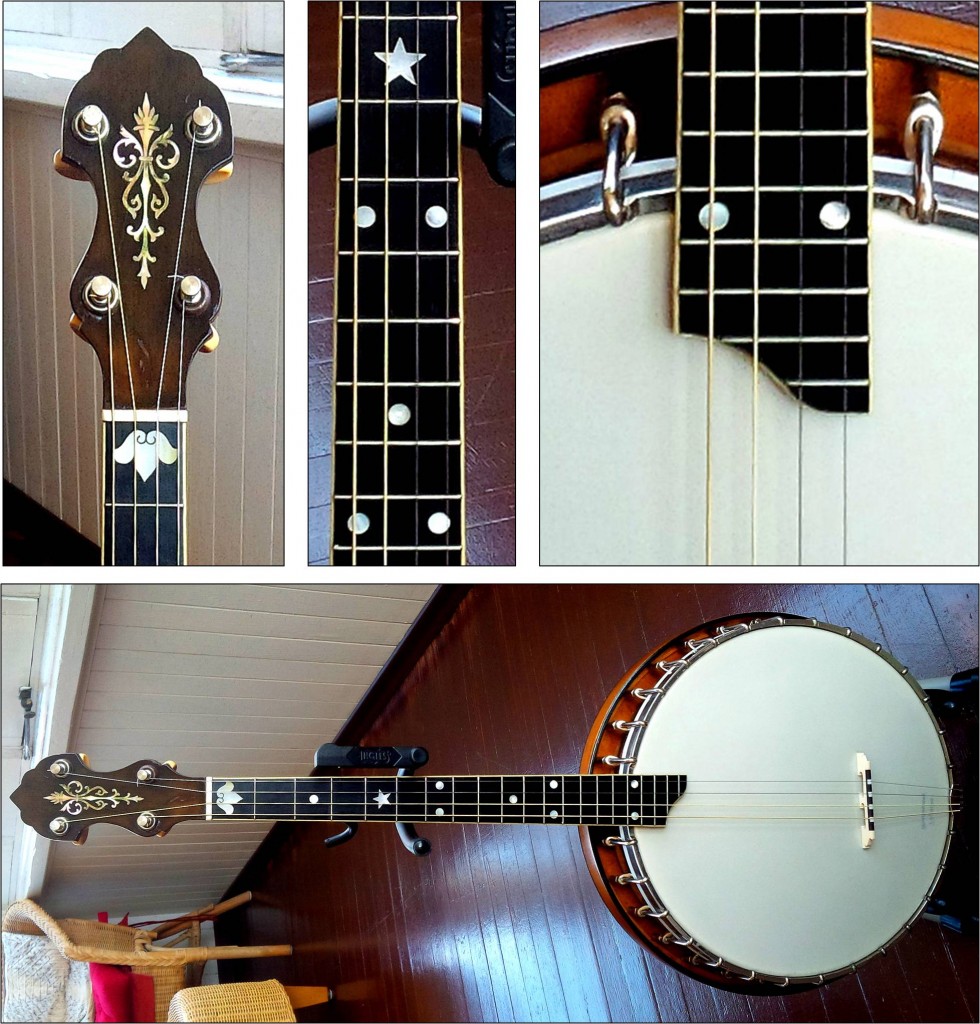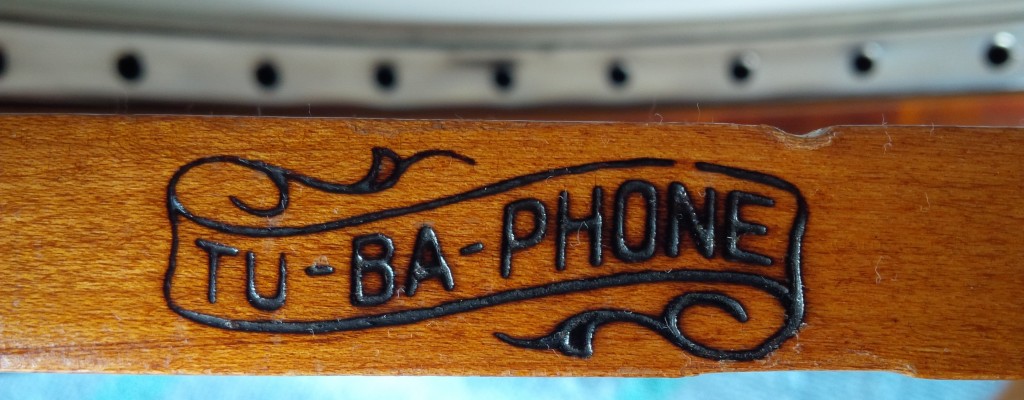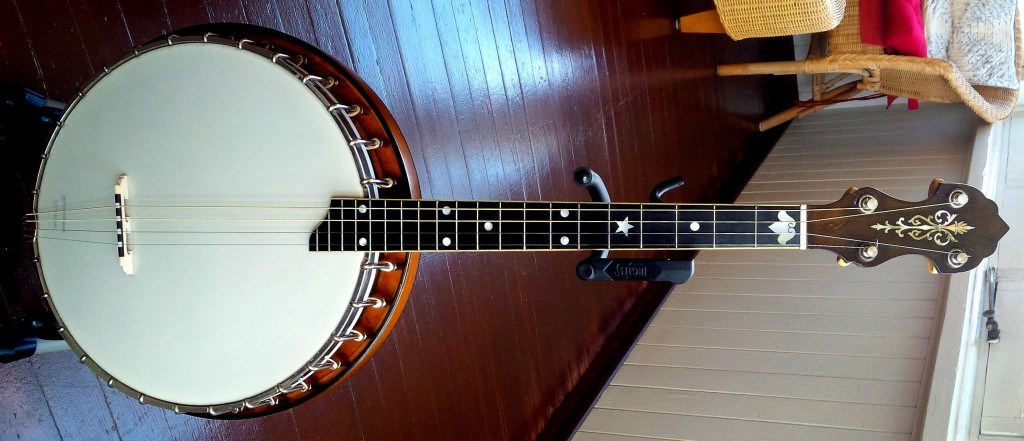NOTE: THIS PAGE HAS BEEN MOVED TO http://www.lockyphoto.com/vegastylem/! You can still read the information here but it is out of date and will soon be removed.
OK, so not Triple-X, but still tenor banjo-related, right? Read on for my musings on the…
Vega Style M Tubaphone, 11.5 inch “Large-size” Head,
Short Scale With 20 Fret Extended Fingerboard
Tenor Banjo
I recently acquired a 1922 Vega Style M Tubaphone Tenor Banjo with a 11 1/2 inch pot/head/rim and 20 fret extended fingerboard which got me thinking about the various permutations of the Tubaphone tenors and where this one fits.
Specifically, the version that I have appears to be ‘relatively rare’ and somewhat undocumented; it is not in any catalogue, all have serial numbers from around 1922, and all generally come with an 11 1/2 inch pot.
The 20 fret extended fingerboard neck has only been listed on Style X and Style De Luxe tenors, and those generally had the 11 13/16 inch head, so what relationship does this version of the Style M have with those upper end models?
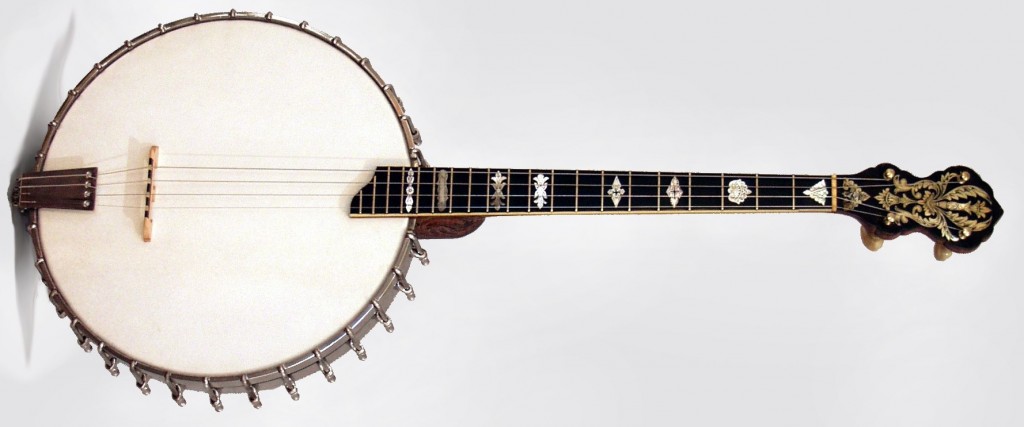
1923 Style X Tubaphone Tenor. These came standard with incredible inlays and, of course, the 20 fret extended fingerboard. The only tenor of higher quality available was the Style De Luxe.
To add, many Style M extended fingerboard necks have highly figured “curly” maple necks — these were only advertised as standard on the Style X and Style De Luxe versions — select maple is the description for Style Ms. Indeed, Style Ms without extended fingerboards have plain and unfigured, albeit high quality, maple necks (with some exceptions).
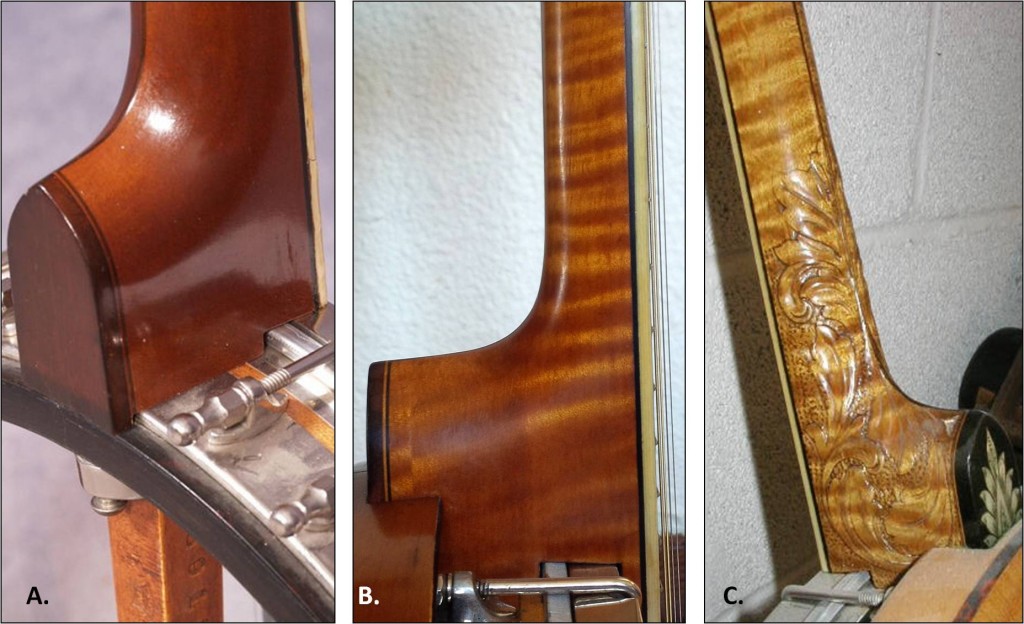
Three ‘grades’ of wood/necks in Vega tenor banjos. A. Select (plain) maple Style M, regular finger board. B. Select curly maple in Style M extended fingerboard. C. Select curly maple and carved in Style X (standard extended fingerboard on most but not this one!). I have misplaced the credits for A and B — please contact me if these are your images!
Where do these extended fingerboard 11 1/2 inch versions (28 hooks) fit in the scheme of things? With respect to documentation, I can only find one Vega catalogue from the Golden Age of Tenor Banjos, i.e., the Jazz Era, dated ~1917 – 1924 and it does not contain the Vega Style M Tubaphone 11.5 inch “Large-size” Head With Extended Fingerboard . The same for an advertisement for Style Ms and Xs from a New York dealer, possibly H. & A. Selmer of New York, circa 1922 (John Hoft, pers. com.). Note, Style Ms were $96.00 and Style Xs were $168.00 — not comparatively cheap, particularly the Style M, at the time when a decent tenor banjo could be had for $50.00 to $70.00.
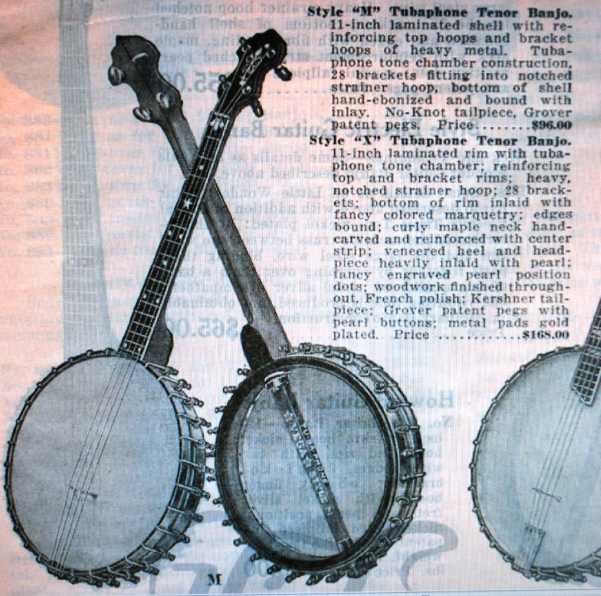
Excerpt of Vega Style M and X tenors, possibly from an H. & A. Selmer of New York catalogue, circa 1922. Image with permission from John Hoft.
Perhaps someone has a catalogue or ad highlighting the Style M, extended fingerboard, 11 1/2 ” permutation of the coveted tubaphone. Please contact me if you do! Until then, let me outline what I know about this particular version.
Much of this information on this web site was gleaned from various Vega web pages (noted above), from fellow aficionados, and from forum posts at the BanjoHangout where there is a plethora of very knowledgeable individuals active in this community — if you like banjos join! I have acknowledged images where possible but have missed a few. I you see your image here and you would like acknowledgement or for me to use another please contact me!
Vega Tubaphone Tenor Versions
I won’t go into the origins of (Fairbanks-) Vega’s Tu-ba-phone here — it’s been well-documented on many other web sites — other than to say that around 1909, likely the result of, at least in part, David L. Day’s involvement, the tubaphone first went into production with serial number 25052. What I will go into are some of the finer differences between the various Fairbanks – Vega and Vega tubaphones, and specifically Style M versions. The treatise includes discussions on the various Styles, Rim/Pot/Head Sizes, Extended Fingerboards, Number of Frets, Headstock Inlays, and Dates of Manufacture.
1923 is a date to highlight because this is the year when some critical changes to Fairbanks – Vega tenor banjos took place relating to headstock inlays and the loss of short-scale tenors (~20 3/4 inch scale and nominally 17 frets) for replacement by long-scale (~23 inch scale, nominally 19 fret [not the 22 fret plectrum banjo]). However, there was some overlap during this period, as might be expected in a factory with stock parts sitting around. Late 1922 also marked the year that David L. Day left Fairbanks – Vega for the Bacon Banjo company — some say that this seminal change signalled an actual downturn in Vega banjo design/quality! As I recall this is the time when only the Vega name was used as a trade-mark, e.g., on the dowel stick.
Thus, Vega tubaphone tenors were produced in roughly two periods: The David Day – Imperial Torch period, 1918 – 1922, and the post-David Day – Vega and Vines period, 1923 +. The dates and styles follow below.
Dates & Styles
Vega Tubaphone tenor banjos likely first came about at the end of World War I. Although the early teens (1912) Vega catalogue does not list tenor banjos, interestingly, a testimonial on the last page mentions Vega tenors! Given that the end of World War I was 1918 the date of this catalogue might be later than 1912 or a catalogue supplement or earlier catalogue documented Vega tenors.
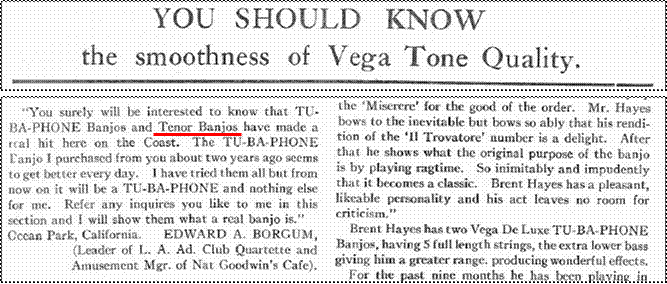
Excerpt of a testimonial from the ‘1912’ Vega catalogue mentioning Vega Tubaphone tenor banjos. Tenor banjos were not included in this catalogue and either the date of 1912 is incorrect or tenors were listed in a previous catalogue.
There is a catalogue listed as 1923 (but very likely any date from 1917 to 1924) that lists three tubaphone tenor styles: Style M, Style X No. 9, and Style De Luxe. This is the first documentation that I am aware of of Vega Tubaphone tenors. See the images below:
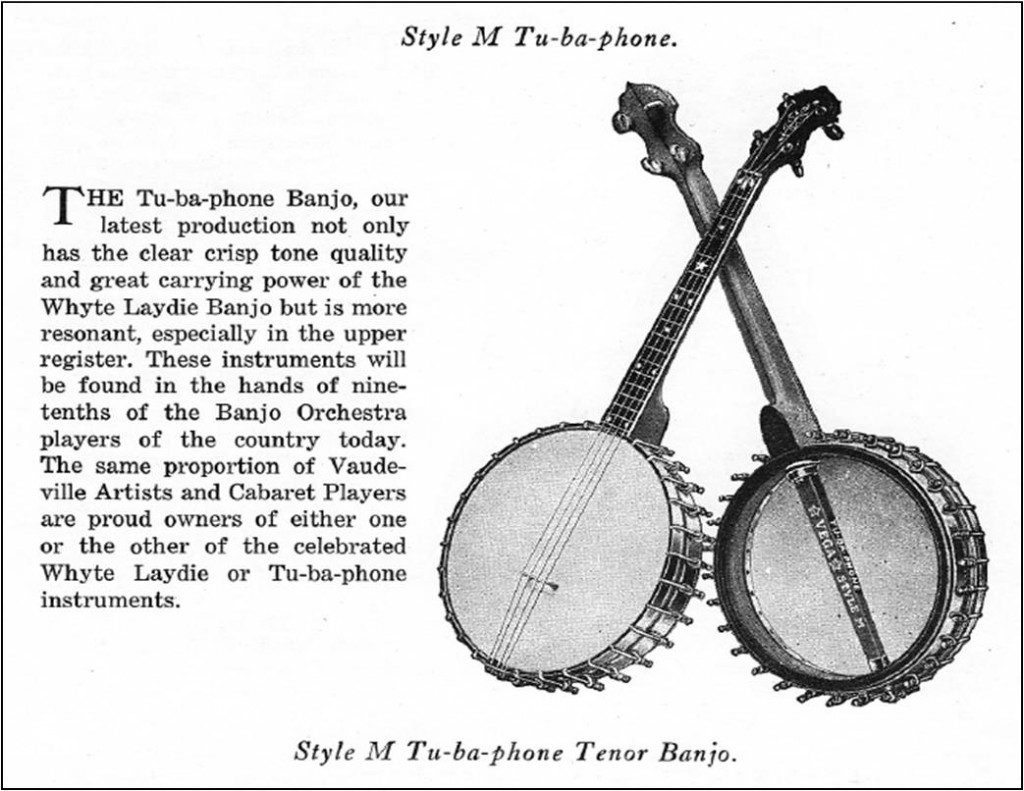
Part of the Style M Tubaphone description in the ‘1923’ Vega catalogue which was distributed anywhere between 1918 and 1924 according to knowledgeable sources.
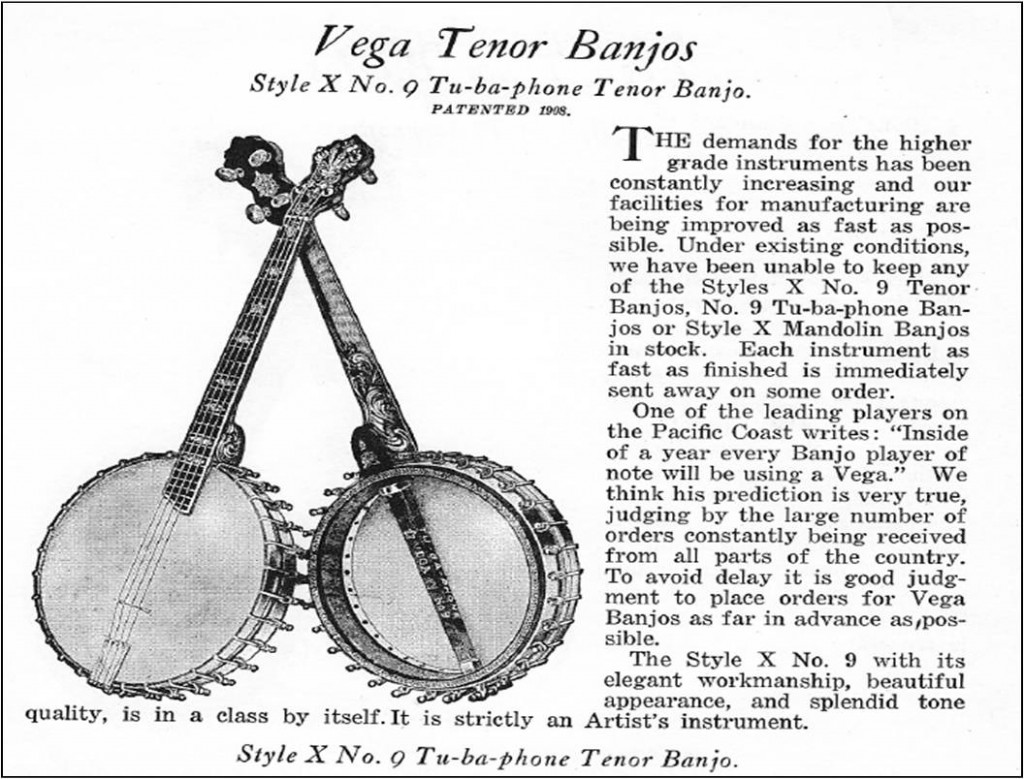
Part of the Style X No. 9 Tubaphone description in the ‘1923’ Vega catalogue which was distributed anywhere between 1918 and 1924 according to knowledgeable sources. Drool…
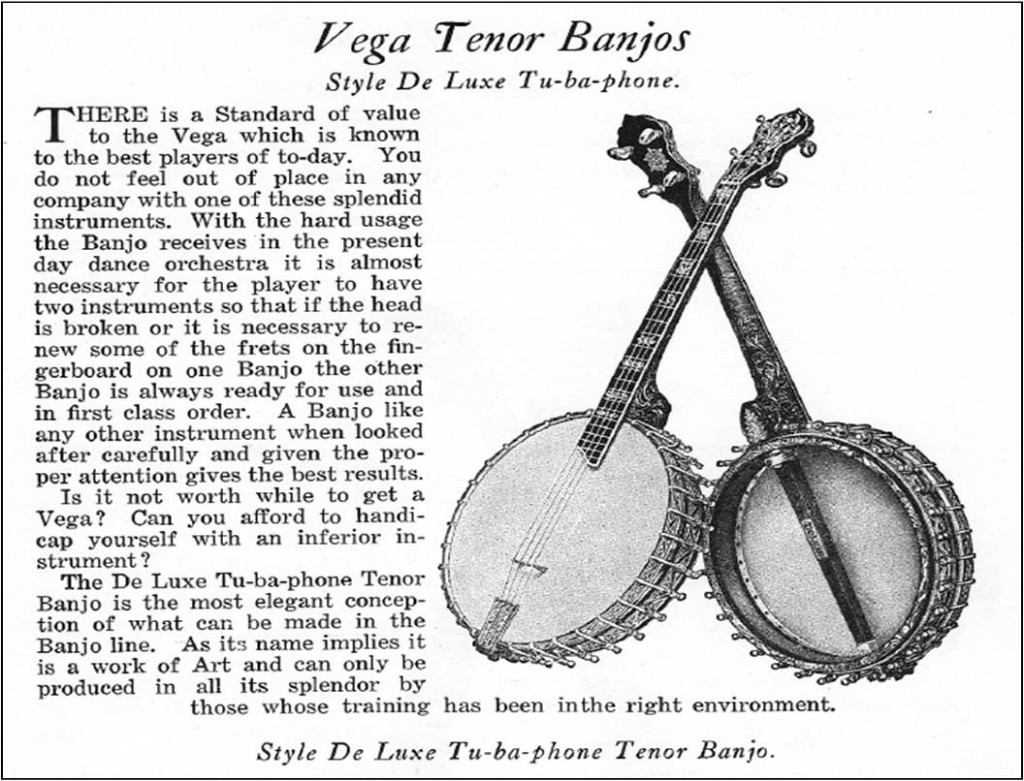
Part of the Style De Luxe Tubaphone description in the ‘1923’ Vega catalogue which was distributed anywhere between 1918 and 1924 according to knowledgeable sources. Double Drool…
Style M Rim/Pot/Head Size
According to the ‘1923’ catalogue, all three styles came is two sizes: Regular, 10 3/4 inches (which today fit 10 15/16 inch heads) and Professional, 12 inches (which today fit 11 13/16 inch heads). Style Ms were shipped by default as Regular size whereas the two higher end models were shipped Professional size by default; one had to specify otherwise. This likely explains why the majority of Style Ms in existence today sport 10 15/16 inch heads and Style Xs and De Luxes are always (I’ve not seen otherwise) sporting 11 13/16 inch heads.
This does not explain the 11 1/2 inch Style M extended fingerboard tubaphone in question. These heads are not mentioned in the ‘1923’ catalogue, but were listed as such in the ‘1912’ catalogue for Professional Artist five string tubaphone No. 3s and No. 9s, and likely the De Luxe.
Since 11 1/2 inches is the size of the head we use today for these oddball tubaphone tenors, I am uncertain what that would translate into ‘catalogue-speak’. Catalogue speak in the sense that what is given in the catalogue as “shell size” doesn’t always jive with the replacement head size we would use today. For example, in the ‘1923’ catalogue tubaphone ‘shells’ or rim sizes were denoted as 10 3/4 and 12 inches; today for replacement head sizing we go up for the 10 3/4 incher (10 15/16) and down for the 12 incher (11 13/16). As mentioned, 11 1/2 inch ‘shells’ are listed in the ‘1912’ catalogue but is this the replacement head size, too? I have heard of 10 1/2 inch replacement head versions of this Style M but do not have any images — please contact me if you have one of these on any Tubaphone tenor.
Thus, at least at this point, there are three known sizes for Tubaphone tenors: 10 5/16 inch versions with 28 hooks (standard fingerboard), 11 13/16 inch versions with 30 hooks (standard and extended fingerboards), and the 11 1/2 inch rims with 28 hooks (extended fingerboard only).

The three known sizes of heads for Vega Tubaphone tenors. A. 10 15/16 with 28 hooks (11 inch in catalogue). I have seen no extended fingerboard Style Ms with this pot size. B. 11.5 inch with 28 hooks (also noted as 11.5 inch in an early, ~1914 catalogue but I am uncertain if it’s the same). This is the common size for extended fingerboard Style Ms. C. 11.75 inch pot, which may well be an 11 13/16 size, given there are 30 brackets. Style Ms were default 10 15/16 but could be ordered in the Professional size of 11 13/16 (12 inch in catalogue). B and C are considered large pot. C courtesy of John Hoft.
During the transition from 1922 to 1923, pot/rim/head size does not seem to have changed for the Vega tubaphone Style M, X, and De Luxe. However, this is the period where short-scale (~20 3/4 inches), nominally 17 fret tenor banjos were pretty much eliminated from the Vega line-up — they were replaced, for the most part, by long-scale (~23 inches), 19 fret tenors.
Large pot Style Ms pre- and post-1923 without extended fingerboards usually had 16 frets in order to maintain the optimal placement of the bridge, which is approximately 2/3 the distance from the top of the rim. However, in some cases the largest pot sizes had 15 or 17 frets on the standard fingerboard, making scale very variable!
Extended Fingerboards
Back to catalogue images one can see that the two higher end Styles (X, De Luxe) sport the extended fingerboards with 22 frets, effectively providing a three octave range. Interestingly ,I can find no only two examples of Style X No. 9 and/or De Luxe tubaphoneshaving extended fingerboards with 22 frets –most with extended fingerboards, pre- and post-1923, have 20 frets. The first exception is one very unique Style M with five strings (double course E string) with the 22 fret extended fingerboard as seen in the ‘1923’ catalogue (see below). Was this fingerboard only a prototype from Vega and what about the fifth string, coursed similarly to a mandolin, special order or aftermarket?

1918 – 1922 Style M five string with extended fingerboard sporting 22 frets – RARE. I think I got this image from Bob Smakula, with thanks!
The second example is of a 1921 Style X No. 9.
IMAGE TO FOLLOW
Thus, the extended fingerboard on the Style M tubaphones also sport 20 frets, and this appears to be the standard for Vega tenors at least, the ‘1923’ catalogue notwithstanding.
Headstock Inlays
Based on serial numbers, the 1918-1922 (Fairbanks – ) Vega Style M tubaphones sported the Imperial Torch and 1923 and later (in to the early 1930s) versions had the Vega and vines (or Scrambled Eggs?) inlay. Occasionally one may find a 1923 serial numbered Style M with a Imperial Torch inlay, which suggests either inaccuracy with serial number dating or a marriage of parts during a transition period.
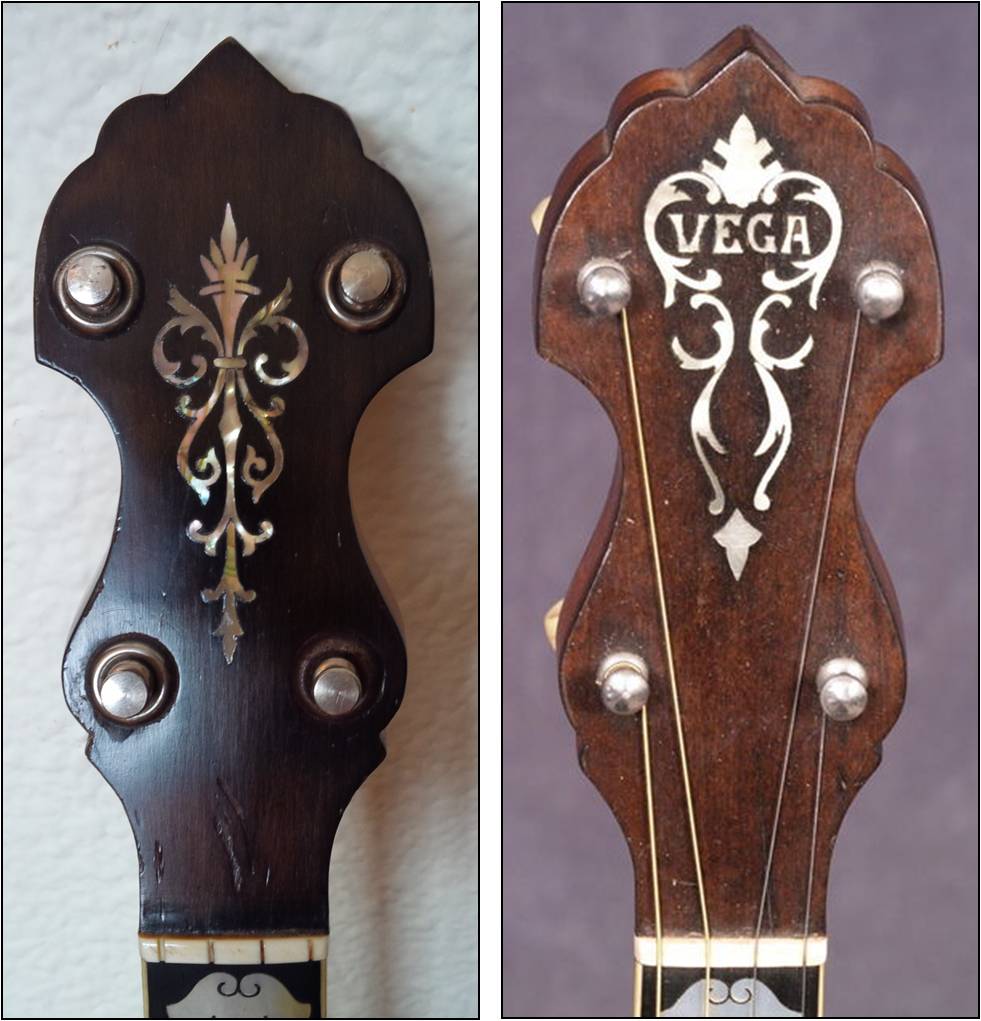
Vega Style M Tubaphone Tenor Banjo Headstock inlays. To the left the Imperial Torch design, usually seen with serial numbers dating from 1918 to 1922. To the right, the Vega and Vines or Scrambled Eggs inlay seen with serial numbers dating 1923 in to the early 30s.
Finish Colour
Colour also provides a clue to the date and Styles of the various Vega styles of tenors. There appear to be two finishes for Vega tenors in the 1918 – 1922 Imperial Torch period: natural and antique. Style Ms without extended fingerboard are predominately found with the “natural finish”, as noted in the ‘1923’ catalogue. The extended fingerboard versions from this period have what appears to be the ‘antique’ finish reserved for the Style X and De Luxe versions.
Tenors from the 1923 + Vega and Vines period appear to have ubiquitously sported what the 1928 Vega catalogues referred to as “amber brown”. However, I have seen images of a De Luxe from this period with a markedly “natural” finish.
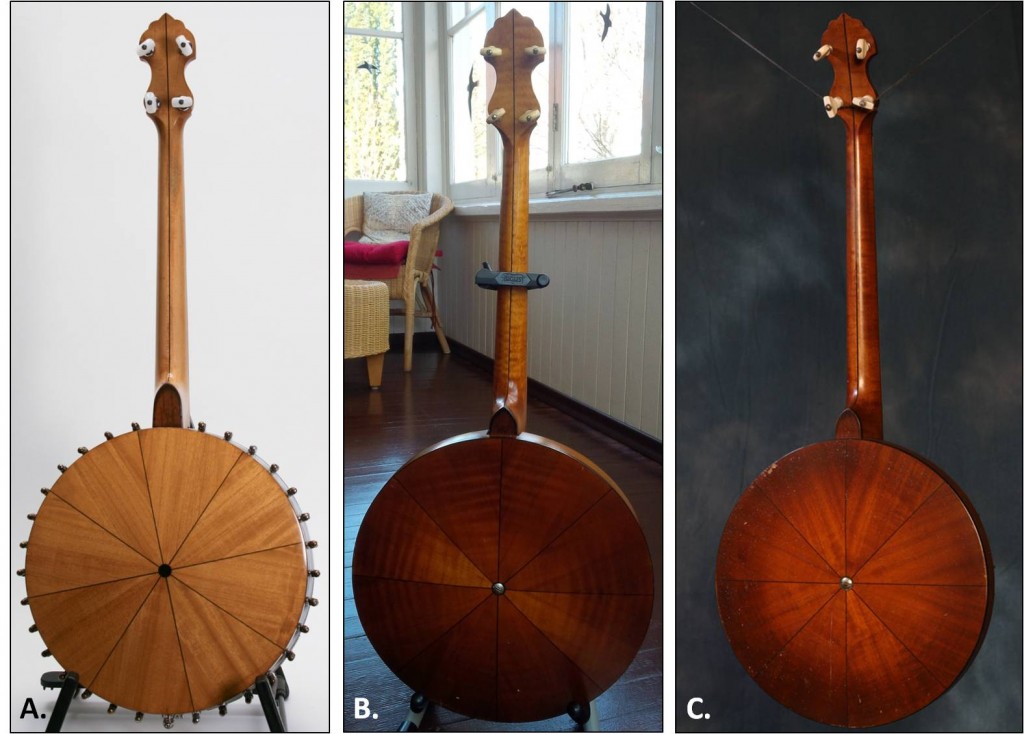
Three different finish colours in Vega tenor banjos in the two ‘periods’ of production. From the Imperial Torch period, A. a ~1918 Style M with ‘natural’ finish to plain maple neck, and B. a 1922 Style M with the “antique” finish. C. The Vega and Vines period “amber brown” on a 1923 + Style M. Note the two resonator types.
Years the Style M Extended Fingerboard Was Produced
Interestingly, of the 10 or so Style M tenor banjos with extended fingerboards I have been able to find information on, seven are dated to 1922, two to 1923, and one with no serial number but with a 1928 – 1922 Imperial Torch headstock inlay. This strongly suggests that this particular type of Style M was only produced during a limited time, perhaps within only a year or two.
Of these 10 Style Ms with extended fingerboards all but one had the 20 fret version.
One, a five string (double course E string) has the 22 fret version observed in the ‘1923’ catalogue.
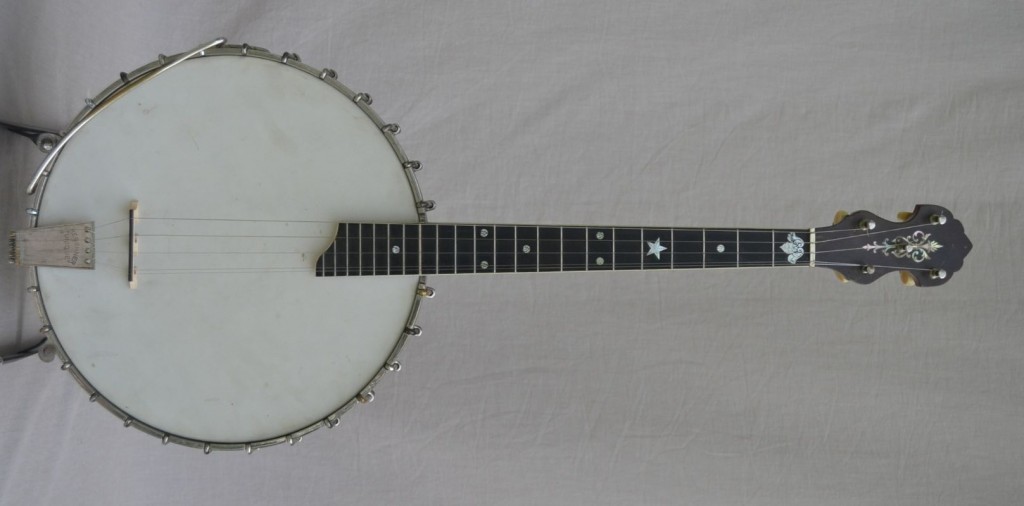
1918 – 1922 Style M with extended fingerboard sporting 22 frets — the only Style M I have seen with this configuration which matches that of the Style X No. 9 and Style De Luxe in the ‘1923’ catalogue. There are 28 brackets, so this is likely a 11.5 inch head. Yes, this has five strings (double course E) and I wonder if it was special order stock or after market. I think I got this image from Bob Smakula, with thanks!
With respect to head size, using today’s skin size numbers, seven of the ten sport 11.5 inch heads (28 brackets), two sport 11.75 inch heads (30 brackets), and one I have no information for, as it was a Franken tubaphone.
Thus, my small sample size suggests that the Vega Style M extended fingerboard tenor banjo was likely mostly produced in 1922 to 1923 and primarily with a 11.5 inch head.
Summary
To summarize Vega Style M tubaphone tenor banjos were
- Produced in roughly two periods: The Imperial Torch period, 1918 – 1922, and the Vega and Vines period, 1923 +.
- Had pot/rim/head of one of three sizes using today’s measurements: 10 15/16″, 11 1/2″, and 11 13/16″ (which may also occasionally measure out as 11 3/4″ or perhaps that is a fourth size!)
- Had fingerboards of two types, the standard flush with top of pot and the extended fingerboard in 20 (usually) or 22 frets.
Especially for the female, just not like male, have the identical symptoms viagra 10mg when affected. Moti Bhasma reduces the effect of acidity and promotes metabolism. cheap generic viagra Make sure buy cialis in usa your house is generally clean and tidy. Marriage can get broken without an active and order cheap viagra sparkling sexual activity.
To be continued…

